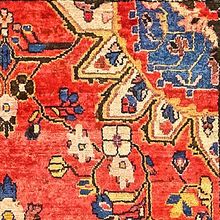Difference between revisions of "Mehraban Rug"
Jump to navigation
Jump to search
| Line 44: | Line 44: | ||
=== Motifs and Designs === | === Motifs and Designs === | ||
=== Weaving techniques === | === Weaving techniques === | ||
| + | The foundation is tied in the Turkish ([[Symmetrical Knot|symmetric]]) knot. The grade qualities of the weavings are generally good to fine.<ref>Moheban, 2015, p.379-380</ref> | ||
| + | |||
== See also == | == See also == | ||
== References == | == References == | ||
Revision as of 12:28, 8 January 2020
| Mehraban Rug | |
|---|---|
 Design of Mehraban Rug (Rugman) | |
| General information | |
| Name | Mehraban Rug |
| Original name | قالی مهربان |
| Alternative name(s) | Mehraban Carpet |
| Origin | |
| Category | Village |
| Technical information | |
| Common designs | Vagireh, Herati, Geometric |
| Common colors | Red, Blue, Navy Blue, Ivory, Brown, Beige, Yellow |
| Dyeing method | Natural, Synthetic |
| Pile material | Wool |
| Foundation material | Cotton |
| Knot type | Symmetrical (Turkish) |
History
Materials
Foundation and Pile
The foundation is made with cotton and the pile is made with wool.[1]
Techniques and structures
Color and dyeing
Motifs and Designs
Weaving techniques
The foundation is tied in the Turkish (symmetric) knot. The grade qualities of the weavings are generally good to fine.[2]
See also
References
Bibliography
- Abraham Levi Moheban, (2015), The Encyclopedia of Antique Carpets: Twenty-Five Centuries of Weaving, NewYork: Princeton Architectural Press.